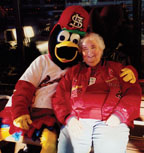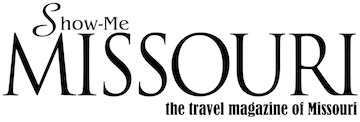
For more than 10 years, Kristen Lokemen was a staff writer and travel specialist for Show-Me Missouri. Over the summer of 2001 she assisted in conducting a tour of the Lewis and Clark Trail from Missouri to the Oregon coast and subsequently penned an 11-part series that ran through the bicentennial observance of the expedition's kickoff. She would eventually lead numerous other tours along that same path, sharing her enthusiasm with hundreds of travelers.
Sadly, Kris died on May 26, 2018. Of all the stories that Kris wrote for Show-Me Missouri, none stand out more than her series on Lewis and Clark's Corps of Discovery. Over the next two weeks, we will run the series in its entirety.
Corps of Discovery: Winter at Wood River
When Lewis and Clark spent the winter of 1803-04 in the St. Louis area, there was no gleaming silver Arch marking the city as the “Gateway to the West.” However, while the little town on the bluff had just over a thousand inhabitants at the time, it was already playing that role.
St. Louis’ location at the confluence of the Mississippi and Missouri Rivers made it the natural “jumping off” point for anyone headed into the western frontier. Prior to the Lewis and Clark Expedition, virtually everyone going west was a fur trapper or a trader. Boats would depart with trade goods and return to St. Louis loaded down with furs for the European market.
But things were about to change. In the spring of 1804 the Louisiana territory would become American land and would-be settlers were chomping at the bit to move into Missouri. The outfitters in St. Louis welcomed a steady stream of customers. One of them was Meriwether Lewis.
The Captain spent most of the winter in St. Louis, residing at the home of Auguste Chouteau. It was Auguste who in 1864, at the tender age of 14, had laid out the original grid for St. Louis on a site chosen by his stepfather, Pierre Laclede. By 1803 Auguste and his brother, Pierre, were among the leading citizens and merchants of the town.
Lewis had left the east with supplies for 15 men. However, the Corps of Discovery had grown much larger. Obviously, that blank check Lewis had been given by Congress would be needed. The Chouteau brothers and a competing entrepreneur, Manuel Lisa, provided the expedition with trade goods, gun powder and bullets, barrels of salt, boxes of candles, knives, blankets and many other items.
However, Lewis was in need of more than just merchandise, and the Chouteaus were able to assist in other ways. They provided information on the tribes of Native Americans the expedition would encounter along the lower Missouri, tribes such as the Osage. They also gave Lewis cuttings from an Osage orange tree which he sent on to Jefferson. Trees from these slips still grow in Philadelphia and on the campus of the University of Virginia.
Lewis sought out anyone in St. Louis who could enlighten him on the territory into which the expedition would be heading. He was given maps by Antoine Soulard, surveyor general of Upper Louisiana, and James Mackay, whose map extended to the Mandan villages in what is now North Dakota. Past that point there was no map.
While Lewis spent most of his time with the gentry in St. Louis, William Clark and the rest of the men were at Camp Wood on the Illinois side of the river making their own preparations for the journey. Clark, concerned about the tribes they would meet, modified the keelboat so that it would be both easier to defend and to maneuver.
A cannon was added to the bow of the keelboat, and blunderbusses on swivels were added to the stern, as well as to each of the pirogues. Lockers were built along the sides of the keelboat. When their lids were raised, they provided a shield for defense. When the lids were lowered, the men could walk on them as they poled the boat upriver.
Clark was also busy assessing the individuals in the Corps as to their fitness for the long, arduous trip ahead. Young men with too much time on their hands could become a discipline problem. They liked to spend time in the nearby whiskey shops and some refused to obey the orders of Sgt. John Ordway, who was in command when both of the captains were gone. Punishments were administered and some men were sent home.
On March 9, 1804 at Government House in St. Louis, the Spanish flag was taken down and replaced by the Tricolor of the French. As most of the city’s residents were of that nationality, emotions ran high, and they requested that the American representative, Capt. Amos Stoddard, allow the French flag to fly over the city for one day. This was done.
The French Tricolor was lowered on March 10 and the stars and stripes of the American flag were raised. Both Lewis and Clark were in attendance for the ceremony marking the transfer of the Louisiana Territory to the United States.
When Clark returned to camp a few days later, he found that the disciplinary situation had worsened. Both John Shields and John Colter had threatened to shoot Ordway for issuing orders to them. The Captains held a trial late in March, charging the two young men with mutiny. Shields and Colter asked for forgiveness, promised to do better and were made part of the permanent party. Both would become valuable members of it.
As the dogwood started to bloom, the time for departure drew closer. Lewis and Clark set up three squads, with cousins Charles Floyd and Nathaniel Pryor joining Ordway as sergeants. Corporal Richard Warfington was chosen to lead a group of five men who would accompany the Corps to the Mandan Villages, then return to St. Louis on the keelboat in 1805.
The permanent party, those who would travel all the way to the Pacific, consisted of 25 enlisted men, Clark’s slave York, George Drouillard, Seaman (Lewis’ dog) and, of course, the two captains. However, only one of the men actually held that rank during the expedition — Meriwether Lewis.
It says a great deal about both Meriwether Lewis and William Clark that the matter of Clark’s commission did not divide them or become known to the men. From the beginning it had been Lewis’ intent that he and Clark would have equal rank and share the command. Secretary of War Henry Dearborn saw the matter differently and assigned Clark the rank of lieutenant. Jefferson did not overturn the decision. While Lewis was embarrassed and Clark disappointed, the rank had no effect on the journey to come.
Lewis had chosen the date of April 18 for departure, but, as the date neared, he realized that more time would be needed to gather additional supplies. They were also arranging to send the chief of the Osage to Washington to meet Jefferson. Pierre Choteau would accompany the chief.
Many of the men wrote letters to their families, not knowing when or if they would be able to communicate with them again. Ordway expressed his happiness at being included in the party when he wrote to his parents and said, “We are to ascend the Missouri River with a boat as far as it is navigable and then to go by land, to the western ocean, if nothing prevents.” He promised to write the next winter if he was able.
Eight French voyageurs joined the expedition shortly before departure. They would paddle one of the canoes and return to St. Louis the next spring. Lewis was in St. Louis making final preparations. Clark, at Wood River, had the men load and unload the keelboat several times, trying to find the perfect balance. The men just wanted to be on their way.
Finally, at 4:00 in the afternoon of May 14, 1804, Clark and the men set off in the three boats. They made four miles that afternoon before camping on an island up the Missouri River. The journey had finally begun.
Previous: The Journey Begins
Next: Setting Out
P.O. Box 53
Kennett, Missouri 63857
Toll-Free: (888) 751-6334
Local: 573-888-1100
Email: info@showmemissouri.net
